Question Regarding Long Trains
Sep 10, 2019 09:19:00 #
tommy2
Loc: Fort Worth, Texas
Living in a large building in town allows me to see two tracks leading to the rail-road yard south of downtown. I sit on the balcony in the morning and watch the trains arriving and departing. One track can be seen looking to the west through the buildings along with seeing it entering the rail-yard to the south. I get a kick out of counting the cars as it crosses a river bridge just before it enters the rail-yard and have become curious just how many cars a single train should be made up of to make the trips cost effective.
Occasionally a string of cars will be 105 to 115 in count - guess the average is around 75 or so. Extra engines must be being moved to different areas too because sometimes there have been 6 or 7 in the line-up. The usual engine count is 3 - 4 moving the long strings. Also wondering if there is a practical limit on train length and if trains are hauling more goods lately?
Thank you in advance, Tommy2
Occasionally a string of cars will be 105 to 115 in count - guess the average is around 75 or so. Extra engines must be being moved to different areas too because sometimes there have been 6 or 7 in the line-up. The usual engine count is 3 - 4 moving the long strings. Also wondering if there is a practical limit on train length and if trains are hauling more goods lately?
Thank you in advance, Tommy2
Sep 10, 2019 09:52:02 #
tommy2 wrote:
Living in a large building in town allows me to se... (show quote)
While I don't know the car count I do know that mile long trains are not unusual. Those "extra engines" could be located mid train and/or at the end of the train. They are mostly there to provide additional breaking power. Trains use compressed air in their brake systems and with longer trains the air pressure will reduce because of minor leaks between cars (multiplied by the number of cars). The additional engines can also help with the overall tractive effort but once the train is moving; an object in motion........ So, their main assist is in braking.
I'll be interested in what more the knowledgeable among us will have to say about this.
Sep 10, 2019 20:34:21 #
I’ll do my best to answer & fill in the blanks. The length of trains in this country is determined by the physics of the routes - grades & curves that are encountered. Also, where the freight is headed. The couplers can only stand so much stress. A 100 car train with no engines in the middle or end can exert 15 tons at the head end couplers. Pulling a whole coupler assembly out of a car is not uncommon. Breaking a knuckle on a coupler is so common that locos carry extra.
The railroad term for power spread throughout the consist is DPU (Distributed Power Unit). The advantage of diesel electrics from late 1930 was that one engineer could control multiple units at the head end. This was done with a four conductor wire between the units. Todays DPU’s are controlled by radio frequency from the head end. All the units must be newer computer controlled locos capable of exactly mirroring the engineer inputs at the head end.
DPU advantages are two fold. 1. Breaking - At consist starting out is able to charge the train 60% faster and break response is 30% faster. As for breaking pressure - air is air - so long as there is 90 lbs in the system the breaks will be applied even if there are no DPU’s. 2. DPU’s greatly reduce coupler strain and starting slap (take up). Locos make extensive use of dynamic breaking which greatly decreases ware on physical air breaks and pads. The engineer reduces the throttle to idle the engages dynamic breaking which turns the traction motors into generators providing resistance to the wheels. The current created is send to a diode bridge which creates heat and dispensed through large fans. This works til about 10 mph when the air breaks are engaged to stop the train. This a very useful in controlling train speed on steep down grades, using breaks when required and preventing over heated breaks.
Newer locos from about the mid 1980’s onward make extensive use of computers and sensors to monitor and control engine and traction motor functions. Gone are the days when an engineer could rough handle the throttle or overload the generator and /or the traction motors. Getting the weight moving is now pretty much controlled by computers. Sensors on the traction motors (axles) can detect potential wheel slip and signal air pressure to shift more engine weight to that axle(s).
Interesting fact: The record for the longest train goes to Australia. A mining company ran 483 full ore cars from the mine to the smelter with 3 head end locos and 5 DPU’s. It was on the the flat outback with no sharp curves.
The railroad term for power spread throughout the consist is DPU (Distributed Power Unit). The advantage of diesel electrics from late 1930 was that one engineer could control multiple units at the head end. This was done with a four conductor wire between the units. Todays DPU’s are controlled by radio frequency from the head end. All the units must be newer computer controlled locos capable of exactly mirroring the engineer inputs at the head end.
DPU advantages are two fold. 1. Breaking - At consist starting out is able to charge the train 60% faster and break response is 30% faster. As for breaking pressure - air is air - so long as there is 90 lbs in the system the breaks will be applied even if there are no DPU’s. 2. DPU’s greatly reduce coupler strain and starting slap (take up). Locos make extensive use of dynamic breaking which greatly decreases ware on physical air breaks and pads. The engineer reduces the throttle to idle the engages dynamic breaking which turns the traction motors into generators providing resistance to the wheels. The current created is send to a diode bridge which creates heat and dispensed through large fans. This works til about 10 mph when the air breaks are engaged to stop the train. This a very useful in controlling train speed on steep down grades, using breaks when required and preventing over heated breaks.
Newer locos from about the mid 1980’s onward make extensive use of computers and sensors to monitor and control engine and traction motor functions. Gone are the days when an engineer could rough handle the throttle or overload the generator and /or the traction motors. Getting the weight moving is now pretty much controlled by computers. Sensors on the traction motors (axles) can detect potential wheel slip and signal air pressure to shift more engine weight to that axle(s).
Interesting fact: The record for the longest train goes to Australia. A mining company ran 483 full ore cars from the mine to the smelter with 3 head end locos and 5 DPU’s. It was on the the flat outback with no sharp curves.
Sep 10, 2019 20:52:40 #
Dave327 wrote:
I’ll do my best to answer & fill in the blanks... (show quote)
Thank you Dave. That is a pretty clear explanation. LOL I had the brake part right just not what brakes or why they were located mid train.
Thanks again.
Sep 10, 2019 21:14:18 #
Sep 10, 2019 21:35:39 #
Dave327 wrote:
I’ll do my best to answer & fill in the blanks... (show quote)
PS: 483 cars, somewhere in the neighborhood of 5 miles long?
Sep 10, 2019 21:51:23 #
Rich1939 wrote:
PS: 483 cars, somewhere in the neighborhood of 5 miles long?
Yes, it took 8 min for the consist to pass the camera. The locos were all modified EMD units. Low clearance for bridges and special air filters that can reverse and blow the heavy outback dust out of the air filters. The same filter modifications are installed on locos shipped to desert countries in Africa. Another tid bit from a big rail fan.
Sep 11, 2019 06:38:39 #
Sep 11, 2019 10:08:02 #
bpulv
Loc: Buena Park, CA
tommy2 wrote:
Living in a large building in town allows me to se... (show quote)
Hi Tommy,
You didn't say where you are located. I live in Southern California and much of the rail traffic in and out of the Los Angeles area consists of unit trains going to and from the LA and Long Beach Harbors. The limit for length of most of those trains is about two miles. I do a lot of photography in the Cajon Pass, a major east-west corridor. Climbing the pass, a unit train may have several head end locomotives, units in the center and pushers at the end. All of them are controlled by radio from the lead locomotive's cab. The pictures below show some of the action in the Cajon Pass where both the BNSF and Union Pacific have tracks.
J. B. Hunt Unit Train (piggyback) Yard loading & unloading operation.
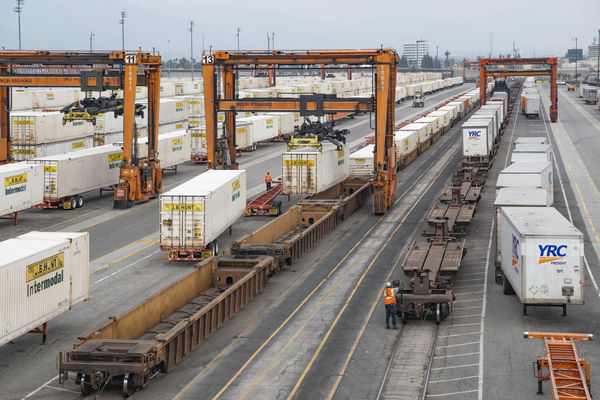
(Download)
Early AM unit train (well cars) in Sullivan's Curve. This is part of one 200 car unit train.
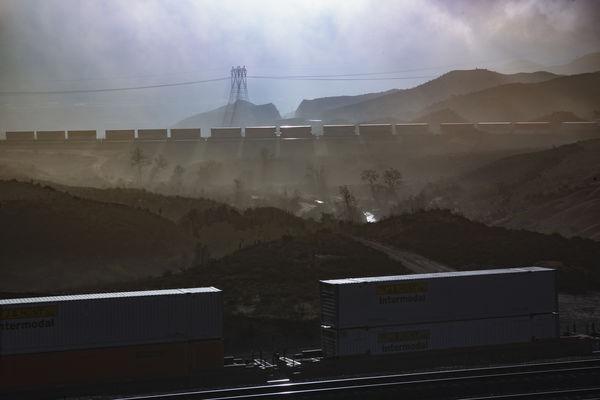
(Download)
Westbound UP passes eastbound BNSF in Sullivan's Curve
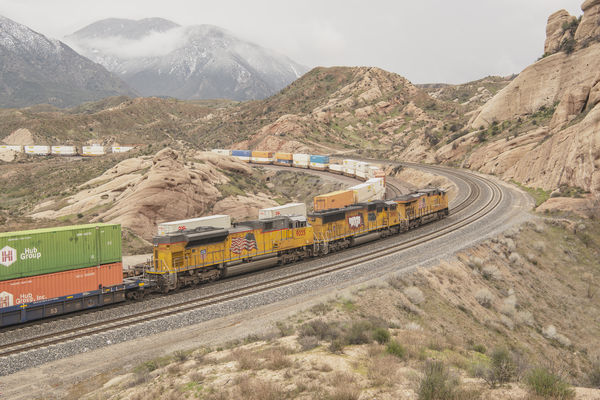
(Download)
Piggyback train uphill from Sullivan's Curve
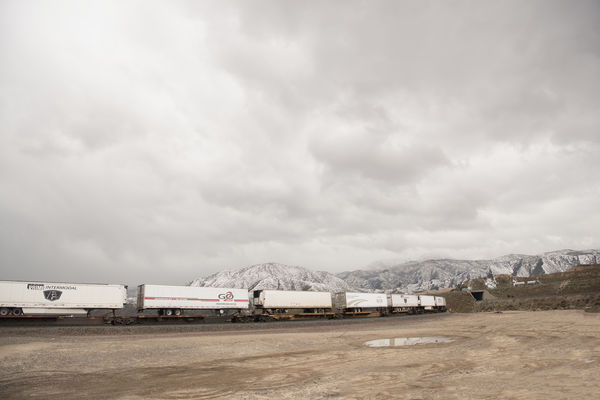
(Download)
Eastbound well train at Cajon Summit at dawn
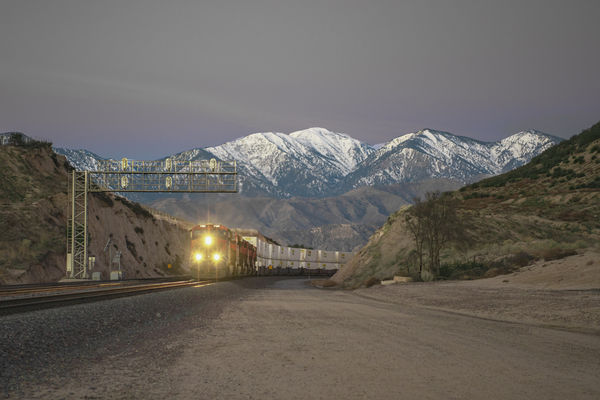
(Download)
Sep 11, 2019 10:33:17 #
dougbev3
Loc: Pueblo, Colorado
The BNSF has started putting two coal trains together , about two and a half miles of train. They have two motors on the head end , 4 in the middle and two on the rear. These trains are running on mountains and plains, sharp curves. Everything is fine until the fat lady sings , then they are chasing their butts to fix the problem. Going uphill, downhill when these trains come apart the conductor and sometimes the engineer have to tie the hand brakes on these cars. If the grade is severe enough about 90% of the train must be tied down to insure the train will not move , until the train is put back together and the air brakes are fully charged with air. Just with a normal mile and a quarter long coal train this process can take a 2 to 3 hours.
Sep 11, 2019 10:43:18 #
bpulv
Loc: Buena Park, CA
dougbev3 wrote:
The BNSF has started putting two coal trains toget... (show quote)
Where is this happening? Coal is heavy. They might have a weight distribution problem. Or, if they are using old equipment, the brakes might not be properly sized for the load. There are a lot of factors and they will figure it out because of the money involved. I have not yet seen anything in Trains Magazine about this problem. If their have been any serious accidents as a result, their newsletters would have flagged it.
Sep 11, 2019 13:55:35 #
I believe the majority of the coal trains doubled together are empty trains so weight is not the major issue. Several crews can be not utilized thus saving crews for revenue producing trains. They're fairly common through Denver on the BNSF.
Sep 11, 2019 14:19:51 #
bpulv
Loc: Buena Park, CA
Mojaveflyer wrote:
I believe the majority of the coal trains doubled together are empty trains so weight is not the major issue. Several crews can be not utilized thus saving crews for revenue producing trains. They're fairly common through Denver on the BNSF.
Thanks for the information and your location.
Sep 11, 2019 14:27:27 #
dougbev3
Loc: Pueblo, Colorado
Mojaveflyer wrote:
I believe the majority of the coal trains doubled together are empty trains so weight is not the major issue. Several crews can be not utilized thus saving crews for revenue producing trains. They're fairly common through Denver on the BNSF.
Both loaded and empty , but more so on the empties.
Sep 11, 2019 14:32:24 #
dougbev3
Loc: Pueblo, Colorado
bpulv wrote:
Where is this happening? Coal is heavy. They might have a weight distribution problem. Or, if they are using old equipment, the brakes might not be properly sized for the load. There are a lot of factors and they will figure it out because of the money involved. I have not yet seen anything in Trains Magazine about this problem. If their have been any serious accidents as a result, their newsletters would have flagged it.
These coal trains are coming out of the Wyoming coal fields and going to Houston, Amarillo. As far as I know ( I'm retired, but my two sons are working ) they are doing more empty coal trains than the loads ; but they are still doing the loaded coal, working out the kinks.
If you want to reply, then register here. Registration is free and your account is created instantly, so you can post right away.




